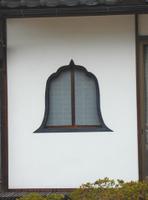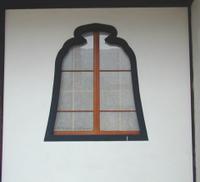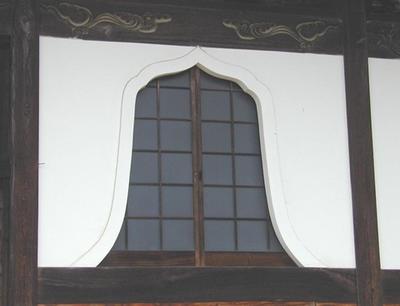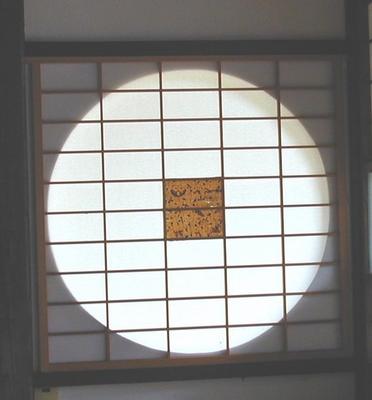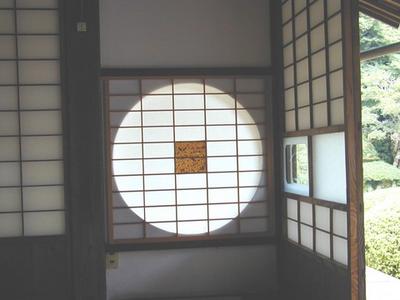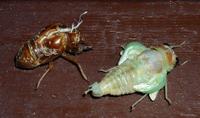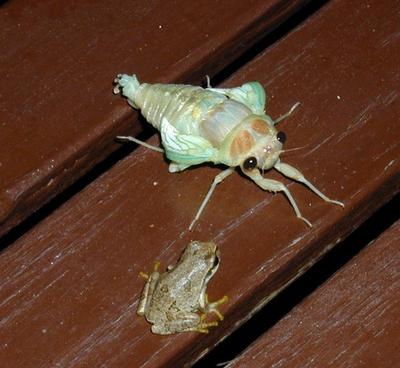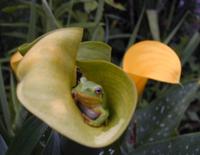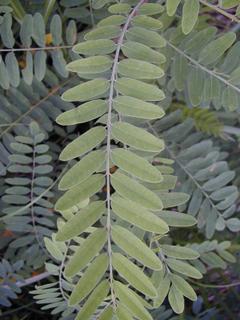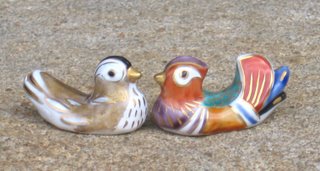[ . BACK to WORLDKIGO . TOP . ]
:::::::::::::::::::::::::::::::::::::::::::::::::::::::::::::::::::::::::::::::::::::::::::::::::::::
knocking
at the wrong door -
woodpecker

er klopft
an der falschen Tür -
Buntspecht
|
In the birdhouse, a family of ants had taken refuge and the woodpecker was eagerly looking for his lunch...
It took him about a week to completely demolish the woody home.
Here is how this haiku came into being:
While I was sitting on the terrace pondering the problems with a haiku friend, the sentence came to my mind:
he seems to be always knocking at the wrong doors...
just at that very moment someone went KNOCK KNOCK KNOCK
so the haiku was born and the woodpecker kept knocking... I never caught him with the camera !
American friend -
the woodpecker knocking
at the wrong door
..................................................

these rotten trees ...
the woodpecker family
works overtime
Gabi Greve, Ocotber 2007
Read about the trees ...
early morning -
a woodpecker's drumming
fills the valley
. Gabi Greve, September 2010
light snow -
a woodpecker hammers
in the silence
. Gabi Greve, February 2011
:::::::::::::::::::::::::::::::::::::::::::::::::::::::::::::::::::::::::::::::::::::::::::::::::::::

woodpecker, kitsutsuki 啄木鳥
kigo for all autumn
family Picidae, Piciformes.
"tree pecker", kitsutsuki 木突(きつつき)
"tree hitter", kitataki 木たたき
kera けら
kera tsutsuki けらつつき
"carpenter bird", takumi dori 番匠鳥(たくみどり)
Woodpeckers are well-known birds, attracting attention with their habit of drilling and pounding trees with their bills to obtain insect food. About 180 species, including sapsuckers and flickers, are classified in several genera making up the subfamily Picinae; together with closely related piculets and wrynecks, they make up the family Picidae.
Woodpeckers are found over most of the world, but not in Madagascar, New Guinea, Australia, or New Zealand.
In Japan the most common woodpeckers are the small woodpecker, kogera 小げら, the red-headed woodpecker, akagera 赤げら and the blue-headed woodpecker, agogera 青げら. Many more species live in the northern island of Hokkaido. They live in Japan the whole year, but are a kigo for autumn because in that season their knocking is most frequent and their colorful bodies most prominent. It is a special pleasure to stand under a tree with bright colored leaves and listen to the knocking sound. In recent years you can also see them trying to knock on the wooden cedar pillar of an electricty pole.
Check the Wikipedia !
Woodpecker
More is here:
http://www.4to40.com/earth/geography/htm/birdsindex.asp?counter=107
Der Buntspecht
:::::::::::::::::::::::::::::::::::::::::::::::::::::::::::::::::::::::::::::::::::::::::::::::::::::
Kobayashi Issa 小林一茶
啄木もやめて聞かよ夕木魚
kitsutsuki mo yamete kiku ka yo yuu mokugyo
is the woodpecker
stopping to listen too?
evening's wooden drum
Tr. David Lanoue
He wrote this haiku on the way back from the grave of his daughter.
. Wooden Fish Gong, Mokugyo 木魚
Prayer Gong in the form of a Fish
.............................................................................
啄木のけいこにたたく柱哉
kitsutsuki no keiko ni tataku hashira kana
a woodpecker
bangs on a house pillar
just for practice
Tr. and comment from Chris Drake:
This hokku is from the 7th month (August) of 1819, not long after Issa's baby daughter has died, and her death may be in the background of the hokku. Judging from Issa's other hokku about woodpeckers in his diary from this period, the bird is probably pecking at a square wooden pillar or vertical beam in the framework of Issa's house, some of which is exposed and not hidden within thick walls. Or perhaps the bird is banging on a vertical beam in a hermitage or small hall near Issa's family temple in his hometown.
His daughter's grave is also near that temple (see my 7/17/2012 Issa translation), and he visited her grave on the 17th day after her death. Issa almost seems to envy the woodpecker, which cheerfully ignores all the distinctions humans make and chooses to peck holes in people's house pillars instead of in trees with insects living in them. There may be a hint of humorous self-criticism in Issa's gentle complaint to the woodpecker that it's ignoring the difference between trees and human houses and thus all too truthfully reminding humans of their transience and mortality.
Further discussion :
- Translating Haiku Forum -
.............................................................................
木つ々きが目利して居る庵哉
kitsutsuki ga mekiki shite iru iori kana
woodpecker
busy appraising
the meditation hut
I've translated the version that appears near the end of My Spring. In Issa's diary the first and second lines are slightly different, though the basic meaning is the same: kitsutsuki no mekiki shite miru.... Judging from the context in My Spring, the hut seems to be a meditation hut Issa saw inside the precincts of or near a temple after he went to pray at the grave of his young daughter on the 17th day after her death, an important memorial day. That temple is most probably Myousenji (明専寺), a Reformed Pure Land sect temple that was the Kobayashi family temple -- and its head priest mediated an end to the inheritance dispute over the house of Issa's dead father.
It was about a five minutes' walk from what eventually became Issa's house (and was his house at the time he wrote the hokku), and the temple graveyard was about five minutes beyond that. In My Spring a hokku to the dead baby girl is followed by two hokku about woodpeckers and then a hokku at the sutra library (kyoudou) of a temple, presumably Myousenji, so the hut is probably near or inside the temple precincts. The hokku just before the above hokku in My Spring also suggests that the hut or hermitage is near the temple. See below.
hito-nembutsu moおusu dake shiku susuki kana
saying a single
Buddha-name, placing
a stalk of miscanthus
This hokku evokes Issa's visit to his daughter's grave, and it is followed by:
will that woodpecker
ever stop and listen? -- monk beats
a wooden fish at nightfall
The first hokku discussed above follows these two hokku and seems to continue the mild bantering with the woodpecker. The hut or hermitage for meditation is a spiritual place, but the woodpecker looks at it with the eyes of an experienced and skilled realtor appraising the hut's physical value, and it seems uninterested in using its beak to make sounds praising Amida Buddha the way the wooden fish does. If the woodpecker were human, it would be thinking in terms of money, but as a bird it must be thinking in terms of the probable number of delicious worms inside the hut's beams and woodwork.
Finally, following the first hokku translated above is one about an experience inside the temple's sutra library hall:
Buddha smiles
and points at
a farting insect
The woodpecker's sounds are here counterpointed by the farting insect. Perhaps at this point Issa comes to regard even the materialistic sounds of the woodpecker and the farting sound of the insect to be amusing Buddha in their own way and thus creating fitting echoes of Issa's own single Buddha-name that might even cause his dead daughter's soul to smile as well.
Chris Drake
More woodpecker hokku by
. Issa with comments by Chris .
kitsutsuki no shine tote tataku hashira kana
kitsutsuki no tonde kara iru iori kana
:::::::::::::::::::::::::::::::::::::::::::::::::::::::::::::::::::::::::::::::::::::::::::::::::::::
木啄や枯木をさがす花の中
kitsutsuki no kareki sagasu ya hana no naka
a woodpecker
searching for dead wood
in the blossoms
--Joosoo (1643-1704), trans. Robin D. Gill
among blossoms
woodpeckers searching
for dead wood
--alternate Gill translation
The woodpecker looks for dead trees
Among the cherry-trees in bloom.
trans. Asastaroo Miyamori
What! mid the flowers the woodpecker
Is seeking out a withered tree.
trans. Basil Hall Chamberlain
Miyamori's comment:
What an unaesthetic bird!
A comment by Charles Horne, from his book, The Sacred Books and Early Literature of the East: Japan, based on Chamberlain's translation:
Highly unesthetic of the bird to neglect the blossoms and prefer a withered trunk.
- Compiled by Larry Bole, Kigo Hotline
. Naito Joso 内藤丈草 .
:::::::::::::::::::::::::::::::::::::::::::::::::::::::::::::::::::::::::::::::::::::::::::::::::::::
kisutsuki ya ochiba o isogu maki no kigi
woodpecker ——
leaves quickly fall
in the meadow
The scene is Akagi mountain of Gunma prefecture. The woodpecker is pecking at the tree and eating insects. People listening to the sound of the pecking, also notice that the leaves were already falling in the meadow. This is one scene of the highland meadows of late autumn.
This haiku is rather new in style, because haiku usually describes in black "sumie" style, but this haiku is written as if in the oil painting style of the French Impressionists. So Shuoshi seems to have the eyes of a Western artist towards Nature, seen in bright sun-light.
Comment by TAKAHA Shugyo.
MIZUHARA Shuoshi (1892 - 1981)
:::::::::::::::::::::::::::::::::::::::::::::::::::::::::::::::::::::::::::::::::::::::::::::::::::::
番匠鳥来てポプラ葉のまだ散らず
takumidori kite popura ha o mada chirazu
woodpeckers coming -
the leaves of the popular
not yet scattered
Hidehiko 秀彦
Tr. Gabi Greve
xxxxxxxxxxxxxxxxxxxxxxxxxxxxxxxxxxxxx
a woodpecker
pecks up
the coconut tree
Narayanan Raghunathan
India, September 2006
:::::::::::::::::::::::::::::::::::::::::::::::::::::::::::::::::::::::::::::::::::::::::::::::::::::
kitsutsuki no hashira o tataku sumai kana
But for a woodpecker
tapping at a post, no sound
at all in the house.
Basho
Tr. Sam Hamill

Tapping Woodpeckers
World Haiku Club 2002
.............................................................................
 啄木鳥も庵は破らず夏木立
啄木鳥も庵は破らず夏木立
kitsutsuki mo io wa yaburazu natsu kodachi
even woodpeckers
don't damage this hut:
summer grove
Tr. Barnhill
Even woodpeckers did not
Damage this hermitage
In the summer grove
Tr. Oseko
About the hermitage of Zen pries Butchoo 仏頂和尚, Butcho, his master, temple Ungan-Ji 雲岸寺.
Basho left this message at the entrance post of the hermitage and left, because the Master was not at home.
even a woodpecker
won't (dare to) damage this hermitage -
summer grove
Tr. Gabi Greve
Oku no Hosomichi, Station 8 - Unganji
. Matsuo Basho 松尾芭蕉 - Archives of the WKD .
:::::::::::::::::::::::::::::::::::::::::::::::::::::::::::::::::::::::::::::::::::::::::::::::::::::
YEMEN
Arabian woodpecker (Dendrocopos dorae)
breeding from February to May
source : www.birdsoman.com
source : Arabian Woodpecker Trecking Tour
surprising chill...
from a lonely acacia
woodpecker's drumming
***
the mulberry tree
provides shade - now on top
woodpecker's drumming
***
how lucky they are
in their yard pomegranates ...
sound of a woodpecker
Heike Gewi, September 2010
. YEMEN SAIJIKI
:::::::::::::::::::::::::::::::::::::::::::::::::::::::::::::::::::::::::::::::::::::::::::::::::::::
[ . BACK to WORLDKIGO . TOP . ]
:::::::::::::::::::::::::::::::::::::::::::::::::::::::::::::::::::::::::::::::::::::::::::::::::::::



